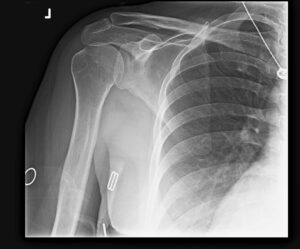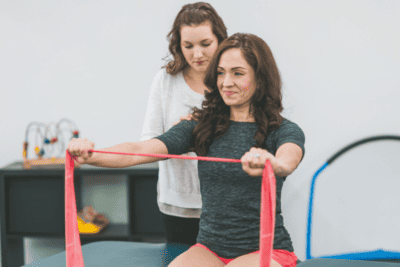The shoulder is one of the most moveable joints in the body, allowing us to lift, rotate, and reach our arms in many directions. However, this great range of motion can also make us prone to shoulder instability. Shoulder instability occurs when the upper arm bone (humeral head) slips out of its normal position in the shoulder socket (glenoid). This can happen temporarily, in what is called a subluxation, or in more serious cases, a full dislocation where the shoulder remains out of place.
- What is Shoulder Instability?
- What Causes Shoulder Instability
- Who is at Risk for Shoulder Instability?
- What are the Symptoms of Shoulder Instability
- Importance of Early Diagnosis and Treatment
- What Treatment Options are Available for Shoulder Instability
- How can you prevent further damage with Shoulder Instability?
Whether you’re an athlete or simply someone who has experienced shoulder pain or injury, understanding the causes, symptoms, and treatment options for shoulder instability can help you protect your shoulder and avoid long-term problems.
What is Shoulder Instability?
Shoulder instability happens when the shoulder joint becomes unstable and the “ball” part of the joint (the top of your upper arm bone) moves out of the “socket” (the part of your shoulder blade). This can occur in two ways:

- Subluxation: A partial dislocation where the ball and socket separate but return to their normal position quickly.
- Dislocation: A more serious condition where the ball stays out of the socket and may need medical help to be put back in place.
Both of these conditions can damage the surrounding tissues in your shoulder and increase the likelihood of future dislocations if not properly treated.
Causes of Shoulder Instability
Several factors can cause shoulder instability, including:
- Traumatic Injuries: Falls, accidents, or sports-related collisions can cause the shoulder to dislocate. For example, landing on your arm or diving headfirst can put stress on the shoulder joint, forcing it out of place.
- Overuse: Repetitive motions, especially in sports that involve overhead activities (such as swimming, tennis, and volleyball), can weaken the shoulder ligaments and make the shoulder more likely to dislocate.
- Loose Ligaments: Some people naturally have looser ligaments, which makes their joints more flexible but also more prone to instability. This can be due to genetics or certain conditions like Ehlers-Danlos syndrome, which affects the connective tissue.
Who is at Risk?
While anyone can experience shoulder instability, some people are at a higher risk:
- Young Athletes: Sports that involve physical contact (like football, basketball, wrestling) or repetitive overhead motions put athletes at greater risk for shoulder dislocations.
- Previous Shoulder Injuries: Once you’ve had a shoulder dislocation, you’re more likely to experience it again.
- People with Loose Joints: Individuals with naturally loose ligaments, such as swimmers, dancers, or those with genetic connective tissue disorders, are more prone to instability.
Symptoms of Shoulder Instability
If you have shoulder instability, you may experience:
- A “popping” sound when the shoulder moves out of place.
- Severe pain and difficulty moving the shoulder.
- A feeling that your shoulder is stuck or unstable.
- Weakness or trouble lifting your arm, especially overhead.
- Repeated shoulder dislocations or the sensation that your shoulder might slip out of place during certain movements.
If you experience any of these symptoms, especially after a fall or injury, it’s important to seek medical attention. Delaying treatment can lead to more serious issues.
Importance of Early Diagnosis and Treatment
Getting your shoulder checked after a dislocation or injury is critical. If left untreated, repeated dislocations can cause long-term damage to the surrounding structures, such as the cartilage, labrum (the ring of cartilage around the shoulder socket), and rotator cuff.
Young people under 30 are especially at risk for repeat dislocations, which can lead to conditions like arthritis down the road. Early treatment can help reduce the risk of further injury and prevent long-term damage.
It is also important to rule out other potential causes of shoulder pain, weakness, or limited function.
Treatment Options for Shoulder Instability
 If you have shoulder instability, there are two main treatment options: non-surgical and surgical.
If you have shoulder instability, there are two main treatment options: non-surgical and surgical.
- Nonoperative Treatment:
- Physical Therapy: A physical therapist can guide you through exercises that strengthen the muscles around your shoulder to improve stability and prevent further dislocations.
- Activity Modification and Bracing: You may need to avoid activities that put stress on your shoulder and, in some cases, use a brace for additional support.
- Medication: Over-the-counter anti-inflammatory drugs (like ibuprofen) can help reduce pain and swelling.
Nonoperative treatment is successful for many patients, and they can return to normal activities within weeks or months.
- Surgical Treatment:
- If physical therapy and other non-surgical treatments don’t relieve the instability, surgery may be necessary.
- Surgery is often recommended for patients who have repeated dislocations, athletes who need a stable shoulder for their sport, or those who have damaged other parts of the shoulder like the labrum or rotator cuff.
- Surgical options include repairing the torn ligaments or labrum, or tightening the loose ligaments to improve stability.
After surgery, a rehabilitation plan will help you regain shoulder strength and mobility, but full recovery can take several months.
Preventing Further Damage
Every time a shoulder dislocates, it increases the risk of damaging the cartilage, bones, and tendons in the joint. Repeated dislocations also raise the chance of developing arthritis in the shoulder. That’s why early treatment and prevention of future dislocations are crucial.
A well-planned treatment approach—including physical therapy, bracing, and possibly surgery—can reduce the chances of future dislocations and protect your shoulder from long-term issues.
Definitely the best decision I’ve ever made was seeking the expert services of Dr. Davis. It’s been years since I’ve been able to move my arm/shoulder in certain directions. I’m still in the mist of my healing, but hands down the best service!
Very knowledgeable and supportive staff. Dr. Davis spends time to understand and explain, my experience through surgery and recovery of torn rotator cuff, labrum, and bicep was outstanding.
Excellent surgeon. My husband needed shoulder repair and Dr. Davis did a great reconstruction surgery. Very good at explaining the details of what needed to be done and how he did it post surgery. He gave realistic expectations and paid close attention to the progress for the PT.
